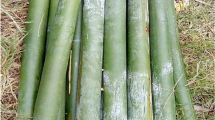Abstract
In the present study, the chemical–physical properties of bamboo pulp prepared with a sequential totally chlorine-free procedure were analyzed and compared with that of commercial wood pulp by SEM, FTIR, TGA, and X-ray. α-Cellulose content was determined to be 95%, a little less than that of commercial wood pulp. But the crystallinity of bamboo pulp is lower than wood pulp. Acetylation activity of bamboo pulp was determined to be higher than that of wood pulp, which was carried out in heterogeneous media with sulfuric acid as catalyst. The cellulose acetate prepared with bamboo pulp can be quickly dissolved in acetone without distinct difference with that of cellulose acetate prepared with wood pulp. The results indicate the potential utility of bamboo as an alternative to wood pulp for cellulose derivate fiber material.







Similar content being viewed by others
References
Antal MJ, Varhegyi G (1995) Cellulose pyrolysis kinetics: the current state of knowledge. Ind Eng Chem Res 34:703–717
Ass BAP, Belgacem MN, Frollini E (2006) Mercerized linters cellulose: characterization and acetylation in N,N-dimethylacetamide/lithium chloride. Carbohydr Polm 63:19–29
Biswas A, Saha BC, Lawton JW (2006) Process for obtaining cellulose acetate from agricultural by products. Carbohydr Polym 64:134–137
Bradbury AW, Sakai Y, Shafizadeh FA (1979) Kinetic model for pyrolysis of cellulose. J Appl Polym Sci 23:3271–3280
Dubey A, Realff MJ, Lee JH (2006) Modeling and inferential control of the batch acetylation of cellulose. AIChE J 52:2149–2160
FAO (1997) Provisional outlook for global forest products consumption, production and trade. Forestry Department, Policy and Planning Division, FAO, Rome
Frisoni G, Baiardo M, Scandola M (2001) Natural cellulose fibers: heterogeneous acetylation kinetics and biodegradation behavior. Biomacromolecules 2:476–482
Han JS, Rowell JS (1996) Chemical composition of fibers, in paper and composites from agro-based resources. CRC Press, London, pp 83–134
Liu CF, Ren JL, Xu F (2006) Isolation and characterization of cellulose obtained from ultrasonic irradiated sugarcane bagasse. J Agric Food Chem 54:5742–5748
Ma NX, Zhang WY, Chen GC (2004) Viewpoints on increasing the national bamboo pulp production for paper making. China Forestry Sci Tech 18:8–11
Obataya E, Minato K (2007) Effects of previous solvent exchange on acetylation of wood. Wood Sci Technol 41:351–360
Rustemeyer P (2004) History of CA and evolution of the markets. Macromol Symp 208:1–6
Shanmughave P (2003) Influence of age on fiber and chemical characteristics of plantation bamboo Bambusa bambos (L.) VOSS. World Bamboo Rattan 1:22–24
Saka S (2004) Wood as natural raw materials for cellulose acetate production. Macromol Symp 208:7–28
Saka S, Takanashi K (1998) Cellulose triacetate prepared from low-grade hardwood dissolving pulp and its insoluble residues in acetylation mediums. J Appl Polym Sci 67:289–297
Sun XF, Sun RC (2004) Comparative study of crude and purified cellulose from wheat straw. J Agric Food Chem 52:839–847
Tosh B, Saikia CN, Dass NN (2000) Homogeneous esterification of cellulose in the lithium chloride–N,N-dimethylacetamide solvent system: effect of temperature and catalyst. Carbohydr Res 327:345–352
Wu J, Zhang J, Zhang H (2004) Homogeneous acetylation of cellulose in a new ionic liquid. Biomacromolecules 5:266–268
Yang K, Wang YJ (2003) Lipase-catalyzed cellulose acetylation in aqueous and organic media. Biotechnol Prog 19:1664–1671
Zhang Y, Ikeda A, Hori N (2006) Characterization of liquefied product from cellulose with phenol in the presence of sulfuric acid. Bioresour Technol 97:313–321
Zhuang X, Wang S, Yuan Z (2007) Analysis of cellulose hydrolysis products in extremely low acids. Trans CSAE 23:177–182
Acknowledgment
We gratefully acknowledge Drs J. Zhang and J. H. Cao for technical assistance and associate professor L. Q. Huang from Donghua University for analytical assistance.
Author information
Authors and Affiliations
Corresponding author
Rights and permissions
About this article
Cite this article
Yang, Z., Xu, S., Ma, X. et al. Characterization and acetylation behavior of bamboo pulp. Wood Sci Technol 42, 621–632 (2008). https://doi.org/10.1007/s00226-008-0194-5
Received:
Published:
Issue Date:
DOI: https://doi.org/10.1007/s00226-008-0194-5




